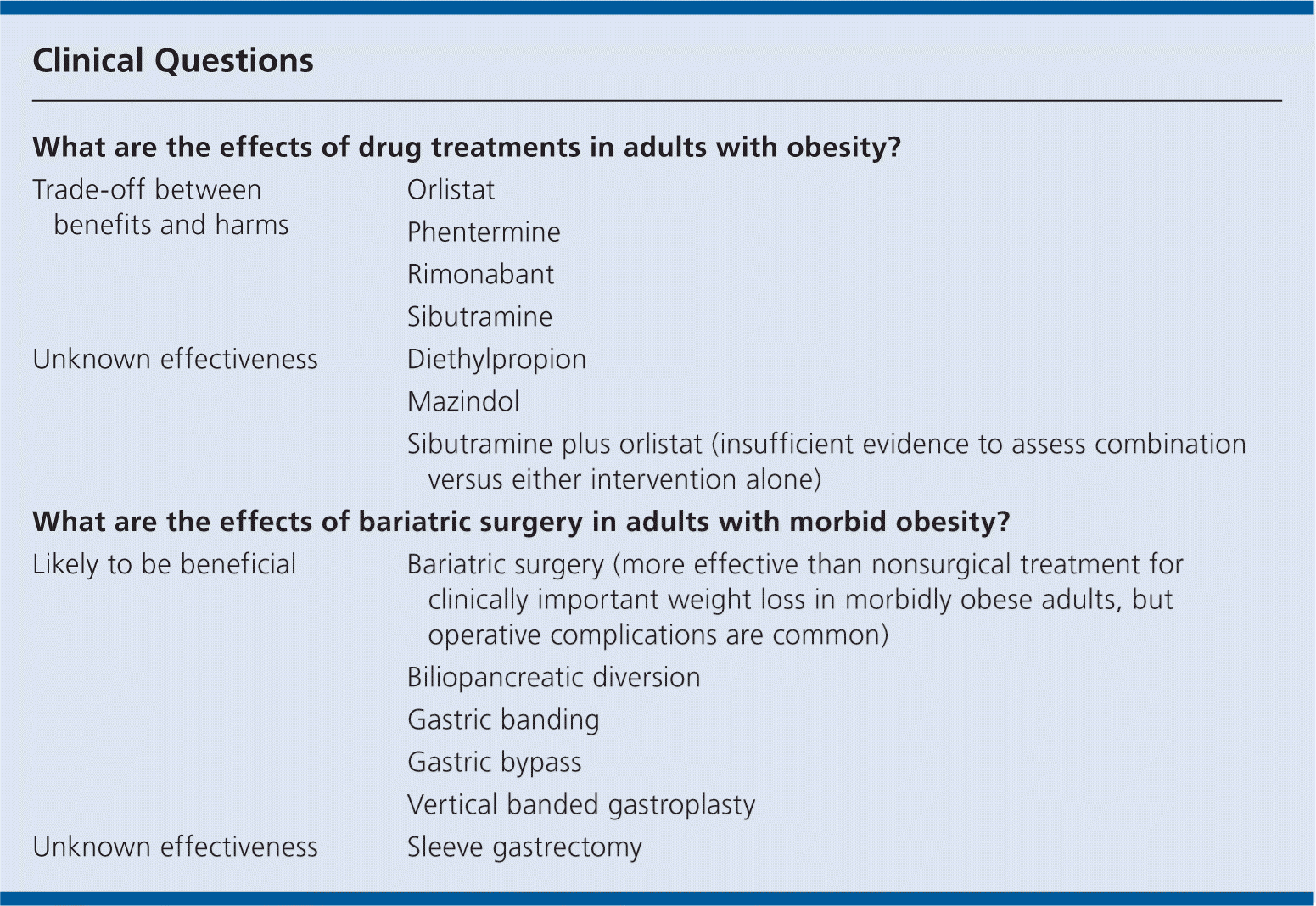
Am Fam Physician. 2010;82(8):974-975
Author disclosure: Nothing to disclose.
About one third of the U.S. population and one fourth of the population in the United Kingdom are obese, with increased risk of hypertension, dyslipidemia, diabetes mellitus, cardiovascular disease, osteoarthritis, and some cancers.
Fewer than 10 percent of overweight or obese adults 40 to 49 years of age revert to a normal body weight after four years.
Nearly 5 million U.S. adults used prescription weight-loss medication between 1996 and 1998, but one fourth of all users were not overweight.
Orlistat, phentermine, rimonabant, and sibutramine may promote modest weight loss (an additional 2.22 to 15.56 lbs [1 to 7 kg] lost) compared with placebo in obese adults undergoing lifestyle interventions, but these medications can cause adverse effects.
Sibutramine may be more effective at promoting weight loss compared with orlistat, although not in obese persons with type 2 diabetes or hypertension.
We do not know whether combination treatment with orlistat and sibutramine leads to greater weight loss than either treatment alone.
We do not know whether diethylpropion and mazindol are effective at promoting weight loss in persons with obesity.
Orlistat has been associated with gastrointestinal adverse effects.
Phentermine has been associated with heart and lung problems.
Sibutramine has been associated with cardiac arrhythmias and cardiac arrest. In January 2010, the European Medicines Agency suspended marketing authorization of sibutramine in the European Union because of the increased risk of nonfatal myocardial infarctions and strokes.
Rimonabant has been associated with an increased risk of psychiatric disorders.
Bariatric surgery (gastric bypass, vertical banded gastroplasty, biliopancreatic diversion, or gastric banding) may increase weight loss compared with no surgery in persons with morbid obesity.
Compared with each other, we do not know whether gastric bypass, vertical banded gastroplasty, biliopancreatic diversion, or gastric banding is the most effective surgery or the least harmful.
We do not know whether sleeve gastrectomy is effective.
Bariatric surgery may result in a loss of greater than 20 percent body weight, which may be largely maintained for 10 years.
Operative and postoperative complications are common and, on average, 0.28 percent of patients die within 30 days of surgery. Mortality may be as high as 2 percent in some high-risk populations. However, surgery may reduce long-term mortality compared with no surgery.

| What are the effects of drug treatments in adults with obesity? | |
| Trade-off between benefits and harms | Orlistat |
| Phentermine | |
| Rimonabant | |
| Sibutramine | |
| Unknown effectiveness | Diethylpropion |
| Mazindol | |
| Sibutramine plus orlistat (insufficient evidence to assess combination versus either intervention alone) | |
| What are the effects of bariatric surgery in adults with morbid obesity? | |
| Likely to be beneficial | Bariatric surgery (more effective than nonsurgical treatment for clinically important weight loss in morbidly obese adults, but operative complications are common) |
| Biliopancreatic diversion | |
| Gastric banding | |
| Gastric bypass | |
| Vertical banded gastroplasty | |
| Unknown effectiveness | Sleeve gastrectomy |
Definition
Obesity is a chronic condition characterized by an excess of body fat. It is most often defined by the body mass index (BMI), a mathematical formula that is highly correlated with body fat. BMI is weight in kilograms divided by height in meters squared (kg per m2). Worldwide, adults with a BMI of 25 to 30 kg per m2 are categorized as overweight, and those with a BMI greater than 30 kg per m2 are categorized as obese.
Nearly 5 million U.S. adults used prescription weight-loss medication between 1996 and 1998. One fourth of users were not overweight. Inappropriate use of prescription medication is more common in women, white persons, and Hispanic persons. The National Institutes of Health issued guidelines for obesity treatment, which indicate that all obese adults (BMI greater than 30 kg per m2) and all adults with a BMI of at least 27 kg per m2 and obesity-associated chronic diseases are candidates for drug treatment. Morbidly obese adults (BMI greater than 40 kg per m2) and all adults with a BMI of at least 35 kg per m2 and obesity-associated chronic diseases are candidates for bariatric surgery.
Incidence and Prevalence
Obesity has increased steadily in many countries since 1900. In the United Kingdom in 2002, it was estimated that 23 percent of men and 25 percent of women were obese. The prevalence of obesity in the United States increased from 22.9 percent between 1988 and 1994, to 34 percent in 2006.
Etiology
Obesity is the result of long-term mismatches in energy balance, in which daily energy intake exceeds daily energy expenditure. Energy balance is modulated by many factors, including metabolic rate, appetite, diet, and physical activity. Although these factors are influenced by genetic traits, the increase in obesity prevalence in the past few decades cannot be explained by changes in the human gene pool, and it is more often attributed to environmental changes that promote excessive food intake and discourage physical activity. Less commonly, obesity may be induced by drugs (e.g., high-dose glucocorticoids, antipsychotics, antidepressants, oral hypoglycemics, antiepileptics) or be secondary to various neuroendocrine disorders, such as Cushing syndrome and polycystic ovary syndrome.
Prognosis
Obesity is a risk factor for several chronic diseases, including hypertension, dyslipidemia, diabetes, cardiovascular disease, sleep apnea, osteoarthritis, and some cancers. The relationship between increasing body weight and mortality is curvilinear, in which mortality is highest in adults with very low body weights (BMI less than 18.5 kg per m2) and in adults with the highest body weights (BMI greater than 35 kg per m2). Obese adults have more annual admissions to hospitals, more outpatient visits, higher prescription drug costs, and worse health-related quality of life than those with normal weight. Fewer than 10 percent of overweight or obese adults 40 to 49 years of age revert to a normal body weight after four years.
